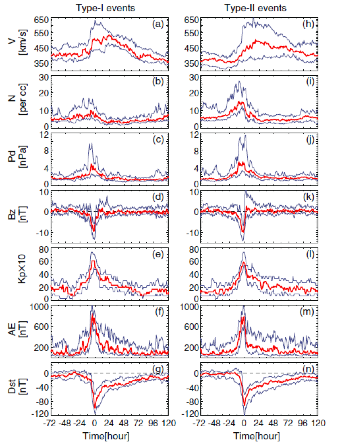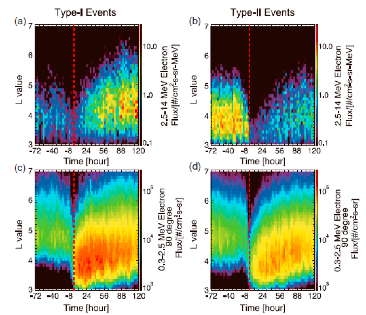磁暴期间外辐射带相对论电子环境是当前空间物理和空间天气研究的一个热点。磁暴以后外辐射带相对论电子通量既可能增强,也可能减少,这给辐射带环境的预报带来了困难。基于SAMPEX和POES卫星的观测数据,我们研究了不同能量相对论电子的通量在1992年7月至2004年6月期间的84个孤立磁暴中的变化。结果表明,不同能量的相对论电子在磁暴期间的变化经常存在明显的差别。随着电子能量的增高(减小),磁暴恢复相期间观测到电子通量比暴前减少(增强)的可能性明显增大。对于0.3~2.5 MeV的电子,在约为87%的孤立磁暴的恢复相期间电子通量增强;对于2.5~14 MeV电子,仅在35%的孤立磁暴中观测到通量增加,而却有45%的磁暴使电子通量减少。我们将这种现象称为暴时相对论电子的energy-dependent response。通过时序叠加分析发现,这种energy-dependent response更容易在太阳风密度较高时出现。有研究表明在太阳风密度较高期间,容易产生电磁离子回旋波(EMIC wave),并且EMIC wave对电子的损失效应也是存在energy-dependent。因此,我们推测暴时的相对论电子的energy-dependent response是由于EMIC波造成的。事例研究表明,在太阳风密度高的磁暴中观测到了EMIC波并且其只能损失高能量的相对论电子(>2.5 MeV)。结合统计研究和事例分析,我们认为EMIC波是导致暴时相对论电子出现energy-dependent response的重要机制。
该成果近期发表在JGR上 (Xiong et al., JGR, 2015;doi:10.1002/2015JA021440)。文章链接http://onlinelibrary.wiley.com/doi/10.1002/2015JA021440/full
文章作者为:熊鹰,谢伦,濮祖荫,傅绥燕,陈伦锦,倪彬彬,李雯,李金星,郭瑞龙,G. K. Parks
研究工作得到国家自然科学基金的支持。
Responses of relativistic electron fluxes in the outer radiation belt to geomagnetic storms
Ying Xiong1,2, Lun Xie1, Zuyin Pu1,2, Suiyan Fu1,2, Lunjin Chen3, Binbin Ni4,Wen Li5, Jinxing Li1,5,
Ruilong Guo1, and G. K. Parks6
1Institute of Space Physics and Applied Technology, Peking University, Beijing, China, 2PKU/UCLA Joint Research Institute
in Science and Engineering, Peking University, Beijing, China, 3Physics Department, W. B. Hanson Center for Space
Sciences, University of Texas at Dallas, Richardson, Texas, USA, 4Department of Space Physics, School of Electronic
Information, Wuhan University, Wuhan, China, 5Department of Atmospheric and Oceanic Sciences, University of
California, Los Angeles, California, USA, 6Space Sciences Laboratory, University of California, Berkeley, California, USA
Abstract Geomagnetic storms can either increase or decrease relativistic electron fluxes in the outer radiation belt. A statistical survey of 84 isolated storms demonstrates that geomagnetic storms preferentially decrease relativistic electron fluxes at higher energies, while flux enhancements are more common at lower energies. In about 87% of the storms, 0.3–2.5 MeV electron fluxes show an increase, whereas 2.5–14 MeV electron fluxes increase in only 35% of the storms. Superposed epoch analyses suggest that such “energy-dependent” responses of electrons preferably occur during conditions of high solar wind density which is favorable to generate magnetospheric electromagnetic ion cyclotron (EMIC) waves, and these events are associated with relatively weaker chorus activities. We have examined one of the cases where observed EMIC waves can resonate effectively with > 2.5 MeV electrons and scatter them into the atmosphere. The correlation study further illustrates that electron flux dropouts during storm main phases do not correlate well with the flux buildup during storm recovery phases. We suggest that a combination of efficient EMIC-induced scattering and weaker chorus-driven acceleration provides a viable candidate for the energy-dependent responses of outer radiation belt relativistic electrons to geomagnetic storms. These results are of great interest to both understanding of the radiation belt dynamics and applications in space weather.



